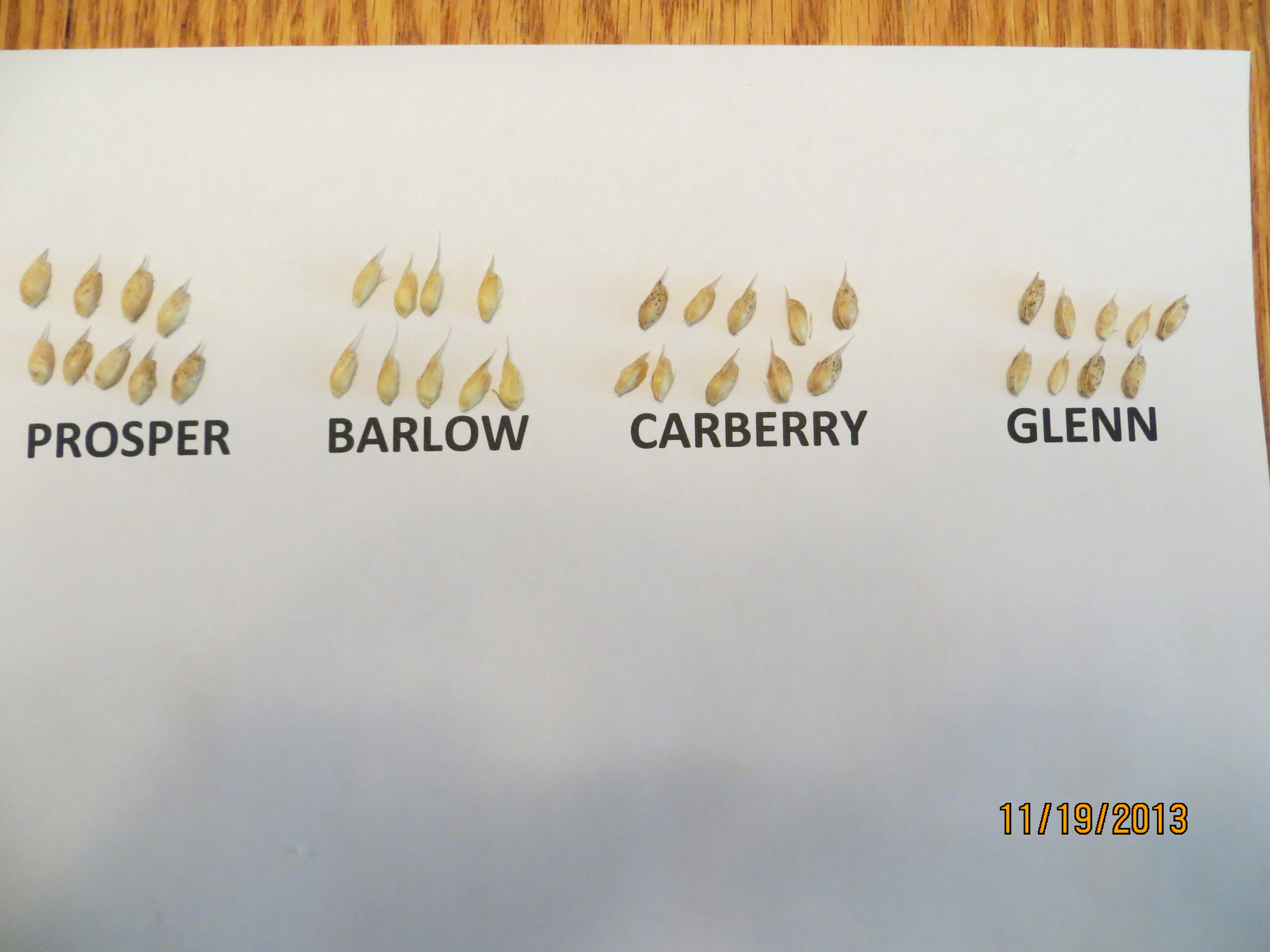Prosper
| Denomination: | 'Prosper' |
|---|---|
| Botanical Name: | Triticum aestivum |
| Applicant/Holder: |
NDSU Research Foundation 1735 NDSU Research Park Drive Dept. No. 4400, P.O. Box 6050 Fargo, North Dakota 58108-6050 United States of America |
| Breeder: |
Mohamed Mergoum, NDSU, Fargo, United States of America |
| Agent in Canada: |
Seed Depot Corporation Box 208 Pilot Mound, Manitoba R0G 1P0 Canada Tel: 204-825-2000 |
| Application Date: | 2012-02-15(priority claimed) |
| Application Number: | 12-7516 |
| Protective direction granted: | 2012-02-15 |
| Protective direction withdrawn: | 2013-05-07 |
| Grant of Rights Date: | 2015-03-10 |
| Certificate Number: | 4998 |
| Exemption from compulsory licensing: | Yes |
| Expiry date for exemption from compulsory licensing: | 2017-03-10 |
| Grant of Rights Termination Date: | 2035-03-10 |
Variety Description
Varieties used for comparison: 'Barlow', 'Carberry' and 'Glenn'
Summary: The lower leaf sheaths and blades of the seedlings of 'Prosper' are pubescent whereas they are glabrous on 'Barlow'. The intensity of anthocyanin colouration on the flag leaf auricles of 'Prosper' is medium whereas it is weak on the reference varieties. The flag leaf blades of 'Prosper' are pubescent whereas they are glabrous on the reference varieties. 'Prosper' is later heading than the reference varieties. The spike of 'Prosper' has weak glaucosity whereas 'Carberry' has medium. The glaucosity of the culm of 'Prosper' is medium whereas it is weak on 'Barlow' and strong on 'Glenn'. The culm neck of 'Prosper' is straight whereas it is slightly curved on 'Barlow'. The lower glume beak of 'Prosper' is medium length whereas it is short on 'Glenn'. The kernel colour of 'Prosper' is dark red whereas it is medium red on 'Carberry'.
Description:
PLANT: hard red spring type, erect growth habit at the 5 to 9 tiller stage, heads emerge early in the season
SEEDLING: absent to very weak intensity of anthocyanin colouration of coleoptile, pubescent lower leaf sheaths and blades
FLAG LEAF: medium frequency of plants with recurved/drooping flag leaves, medium anthocyanin colouration of auricles, absent or very weak glaucosity of sheath, pubescent blade, glabrous sheath
CULM NECK: absent or very sparse hairiness on uppermost node, medium glaucosity, straight
STRAW: thin to medium pith in cross section, no anthocyanin colouration at maturity
SPIKE: weak glaucosity, parallel-sided shape in profile, medium density, white at maturity, erect attitude, sparse hairiness on convex surface of apical rachis segment
AWNS: shorter than length of spike, white
LOWER GLUME: medium oblong shape, medium length, narrow to medium width, absent to very sparse extent of internal hairs
LOWER GLUME SHOULDER: narrow, straight to elevated shape
LOWER GLUME BEAK: medium length, straight
LOWEST LEMMA: straight beak shape
KERNEL: dark red, small to medium size, short to medium length, medium width, oval shape, rounded cheek, medium length brush hairs, narrow width and shallow depth of crease
GERM: medium to large in size, round shape
Origin & Breeding History: 'Prosper' (experimental designation ND808) is the result of the final cross using the modified pedigree and bulk methods made at North Dakota State University (NDSU), Fargo, North Dakota in the fall of 1997. The pedigree is ND2857/Dapps. The F1 plants were grown in a greenhouse at NDSU in the spring of 1998. The F2 to F5 were selected, threshed individually and advanced. In the fall 2000 to spring 2001, the F5:6 generation was advanced and increased in a winter nursery in Christchurch, New Zealand and was harvested in bulk. In the summer of 2001, the F7 was grown in intermediate yield trials at NDSU research farms in Casselton and Prosper, North Dakota. Four spikes from a selected plot from Casselton were harvested, threshed separately and sent to New Zealand for purification and seed increase. The F7:8 were harvested in bulk and sent for yield trials in 2003. The F9 to F11 were tested in Elite yield trials in 2002, 2003 and 2004. ND808 was designated at this time. The line was tested in the summers of 2005-2010 in statewide yield trials at 7 locations. It was released in January 2011. Selection criteria in the early generations included plant vigor, height, maturity and pest resistance. In later generations, selection criteria included grain yield, lodging resistance, shattering resistance, test and kernel weights, disease resistance and milling and bread making qualities.
Tests & Trials: Tests and trials for 'Prosper' were conducted during the summer of 2013 in Rosebank, Manitoba. Plots consisted of seven rows with a row length of 5 metres and row spacing of 18 cm. There were 3 replicates. The tests and trials were supported by the test report purchased from the Plant Variety Protection Office, Beltsville, Maryland, USA PVPO# 201100402.
Comparison table for 'Prosper' with reference varieties 'Barlow', 'Carberry' and 'Glenn'
Days to heading
| 'Prosper' | 'Barlow' | 'Carberry' | 'Glenn' | |
|---|---|---|---|---|
| 2013 | 44 | 41 | 42 | 42 |
Click on image for larger view

Wheat: 'Prosper' (far left) with reference varieties 'Barlow' (centre left), 'Carberry' (centre right) and 'Glenn' (far right)
Click on image for larger view

Wheat: 'Prosper' (top left) with reference varieties 'Barlow' (bottom left), 'Glenn' (top right) and 'Carberry' (bottom right)
- Date modified: